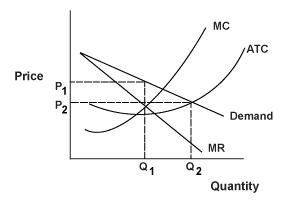Monopolies vs. Perfect Competitions
A market characterized by monopoly has only a single seller, while a perfectly competitive market has many sellers. There are high barriers of entry with the monopoly, but little to no barriers to entry in the perfectly competitive market. Because the product of a monopolist cannot be substituted readily, the monopolist can set a higher price and still get sales.
The seller in a perfectly competitive market cannot get a higher price because potential buyers always can get the product from other sellers.
Major inefficiencies associated with monopolies include:
·Allocative inefficiency - prices will tend to be higher, and output lower, than what would exist in a market with low barriers to entry. Prices will tend to be higher than both marginal costs and average total cost.
·Weakened market forces - when consumers of a product have many alternatives, producers must serve their customers efficiently in order to stay in business. If consumers can't purchase competitive products easily, the monopolist doesn't need to worry a lot about losing customers when poor service or a poor quality good is provided.
·Rent or favor seeking - firms and/or individuals will put a great deal of effort into obtaining or maintaining high entry barriers; by doing so, they hope to achieve monopoly-type profits. Such efforts enrich some people, at the expense of many others.
Price Discrimination
Price searchers effectively price discriminate among their customers when they are able to:
a) identify sub-groups which have different elasticities of demand, and
b) ensure that the customers cannot resell the good.
A common example is airline travel. Travelers who plan in advance will have a higher elasticity of demand than travelers who must travel within a short period of time.
With price discrimination, some consumers pay higher prices than they would if there was a single price. However, many in the group paying lower prices will now be getting something they otherwise would not have purchased. Universities are increasing their use of price discrimination.
Tuition rates for students without financial aid are increasing greatly while the average price charged is not going up as much because more financial aid is being offered. The colleges reap high revenues from wealthy families who can afford to pay high tuition while more students from lower-income families can now attend college.
In general, higher output will occur with price discrimination. Furthermore, there may be some businesses that could not exist without price discrimination. For example, a dentist in a small town may not have a viable business without performing price discrimination.
As price discrimination increases output and gains from trade, it reduces allocative inefficiency. Firms that successfully price discriminate will benefit by getting higher revenues.
Why Do Monopolies Exist?
If a natural monopoly is to exist, the government can regulate the price and output. In the graph below, the monopolist would prefer to charge price P1 and Q1 to maximize profits. A regulatory agency will often set the price at P2. At this price, the monopolist receives enough to cover costs and, in effect, it receives a competitive rate or return of its capital. The benefits to society from the increased production outweigh the increased costs to the monopolist.
Figure 3.13: Results of Regulating Price and Output
 |






0 comments:
Post a Comment